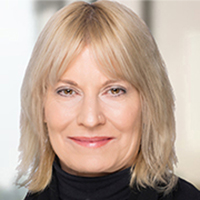Judy Wade, Managing Director and Head of San Francisco at CPP Investments, explains why we should be excited about technology investment trends that have the potential to disrupt the system.
KAT USITA: What trends in technology investments and opportunities from disruption are you most excited about? How have these trends evolved over the last few years?
JUDY WADE: Just to set the context, we opened the San Francisco office for several reasons. First, we are excited about opportunities for investing. Second, we wanted to understand what kind of technology might further enable our investment and drive improvements in our portfolio companies. Third was to gain awareness of disruptions or big changes driven by technology that we should be taking advantage of. Finally, for our own operations, we want to identify technology solutions and data that can improve our ability to generate alpha.
One area that cuts through all four things is machine learning and artificial intelligence. In the last few years, the promise and actual real opportunity are coming together. That is because of the venture capital funding, experience, computing power and actual data that are available, all of which companies can take advantage of. We’ve invested in Databricks and Signifyd, a data engineering and analytics platform and an ecommerce fraud protection platform, respectively. There are other things that we have not necessarily invested in but are excited about, like Aero Technology, which uses AI in core operational decisions such as supply chains of consumer-packaged goods.
Climate change is another area. There is a lot on the defence side of climate change, but there are ways we can further transition to a carbon-neutral world through our investments. We are doing that both in our thematic investing group and our newly formed sustainable energies group, where we have invested in everything from electric vehicle company ChargePoint to a new company that uses concrete to sequester carbon.
Our sustainable energies group came together from two sides of our real assets group: energy and resources, and power and renewables. We have created one group focused on opportunities around sustainable energy and the energy revolution. Renewable energy company Pattern Energy is an investment on that side.
We also believe that we have to invest in technologies that will help traditional energy industries become more carbon efficient. We need to help them transition rather than ignore them and think that they’re going to disappear.
I would also highlight fintech. It started out with firms picking pieces off larger financial institutions. But you’re starting to see those fintech companies rebundle and offer multiple services. Lastly, we’re excited about education as well. Covid-19 has really brought the future faster, exposing socioeconomic disparities in education that we think technology can help solve.
KU: Are asset owners and asset managers moving quickly enough to take advantage of these opportunities?
JW: Machine learning and AI are definitely priorities for many CEOs and investors. For large enterprises, it’s one thing to identify these tools. But actually translating that through the organisation, getting people to adapt and using it for investment decision-making is a challenge. Broadly, that’s probably the same challenge for asset managers as it is for large enterprises. Tech and data is a big priority for us, but we are still in the early stages of identifying opportunities and driving them fully through all of our investment and asset management processes.
KU: What are CPP Investment’s key priorities for the San Francisco office?
JW: I led some research on tech ecosystems and one of the insights I got from it is that capital is not really a differentiator in tech ecosystems. These ecosystems are awash in capital, so the real differentiators are bringing expertise and connections. One priority for us is to build strategic relationships in the ecosystem, and not just with companies we invest in. More broadly, we want to bring our global expertise, our values and our own insight to other partners within the ecosystem, so that they will also be willing to share what they are seeing and doing.
Second is using those strategic relationships, along with our own research, to identify super early trends that might not be right on the horizon for investment departments but might bring the next level of disruption or opportunity. There are a lot of interesting things happening with quantum computing, for example. The jury is still out on when it will be deployed at scale, but the potential to drive exponential innovation in drug discovery, the chemical industry and in reducing our carbon footprint, to name a few, is enormous.
Third is to make CPP Investments into a bit of a culture lab, if you will. Tech companies have pushed the envelope for how organisations work. We want to bring some of the new ways of working back to the fund, especially around collaboration and agility.
KU: How is CPP Investments able to leverage its global presence to find strategic opportunities in different regions?
JW: One way is through early signals from one region to another. Seeing things play out in one region can create investment opportunities in others. To give you an example, there are ‘super apps’ in Asia that combine multiple apps, whether it’s banking, shopping or connecting with your friends. We have not seen that happen in Europe or the US. You can take a step back and think about why that is the case. What is that going to mean in terms of opportunity? What is translatable, and what is not?
Second, relationships we build in one region can really drive opportunity for us in others. We just invested in Loft, a Brazilian unicorn that is now among the most highly valued start-ups in the region. They are basically a residential marketplace for buyers and sellers of homes. Loft originally came through our credit team and relationships in São Paolo. We then brought in our venture capital team to do a co-investment with one of our general partners here in Silicon Valley.
That ability to fluidly work across both investment departments and regions to bring opportunities to the table is a second thing that drives advantaged deal flow for us.
The third way is around shared learnings between regions. I am the co-sponsor of a virtual education team doing research on structural shifts and how the future has come much faster for this sector. It’s really interesting to compare how education is evolving in Southeast Asia, China and Europe versus the US, and what that means for investment opportunities. We are investors in Nord Anglia, which operates brick-and-mortar private schools. That investment was done out of our Asia offices. Since Nord Anglia was keen to bring themselves into the digital world, we connected them with Learn Capital, one of the lead investors in education technology, here in Silicon Valley. We were able to make that cross-region introduction because of our global presence, and through sharing our learnings in the virtual team.
KU: Diversity and equity are important issues across the investment community, more so in the past few years. How does CPP Investments think about tackling this issue in Silicon Valley, and ensure it is bringing and welcoming diverse perspectives to the table? How does that fit with your investment-only mandate?
JW: You need to have a solid foundation, and CPP Investments has done a really great job with gender parity. Our senior management team is 36% female. We have achieved gender parity in hiring, with women representing 46% of our global workforce. We use our proxy votes to advance diversity on boards. For boards in North America, developed Europe and Australia, we will oppose the election of the chair of the board committee responsible for director nominations if the board has fewer than 30% female directors. With our own houses in order, we can use our capital, our influence and our position to nudge our partners along that path. With that as the foundation, you can then broaden diversity and inclusion to include diverse ethnic backgrounds. Despite all the focus on race this last year because of George Floyd, VC funding to diverse entrepreneurs went down, which was not even very big to begin with. The tech ecosystem is particularly susceptible to the cognitive biases you would see in behavioural economics that affect who you hire and who you fund. Entrepreneurs are much more likely to exhibit overconfidence bias than the average population, which could be a good thing in creating new companies. The dark side of that includes anchoring bias, gambler’s fallacy and other biases, which tend to mean that you hire people that look like you and have the same path as you.
We have been investing in a project to de-bias investment decision-making, which is a relatively new field. We all have cognitive biases, which are there to help us make decisions more efficiently. We need to recognise when they’re positive, and when they can cause you to make investment decisions you probably shouldn’t make. For example, with loss aversion, you might hold on to an investment longer than is rational because you are worried about the loss. With regret aversion and herd mentality, you might invest in something because everyone else in investing in it.
Here in the Valley, people tune out a bit when you talk about unconscious bias because they may not realise how it affects who you fund and who you hire.
Diversity supports our mandate to maximise returns because diverse opinions and experiences, as well as avoiding groupthink, help us identify new opportunities for the Fund.
We want to address cognitive biases to improve our investment returns, and hopefully, through our own experience, help others look at diversity and inclusion in a slightly different way.
This article was originally published in Global Public Investor 2021 by OMFIF, on July 21, 2021. View the original article here.
About the Author
Judy Wade
Managing Director, Head of Strategy Execution & Relationship Management
Judy heads our San Francisco Office and oversees our Bay Area growth strategy.
Prior to joining CPP Investments in 2020, Judy led McKinsey & Company’s practice serving startups and their investors. She also spent 10 years as a CEO or Senior Executive in various startups in gaming, digital health and big data. She started her career at McKinsey focused on education and technology.
Judy holds a Masters in Public Policy from Harvard’s Kennedy School and a BA in Economics from University of California, Berkeley.
Judy is co-Chair of the Board of UC Berkeley’s College of Letters & Science.
Judy Wade, Managing Director and Head of San Francisco at CPP Investments, explains why we should be excited about technology investment trends that have the potential to disrupt the system.
KAT USITA: What trends in technology investments and opportunities from disruption are you most excited about? How have these trends evolved over the last few years?
JUDY WADE: Just to set the context, we opened the San Francisco office for several reasons. First, we are excited about opportunities for investing. Second, we wanted to understand what kind of technology might further enable our investment and drive improvements in our portfolio companies. Third was to gain awareness of disruptions or big changes driven by technology that we should be taking advantage of. Finally, for our own operations, we want to identify technology solutions and data that can improve our ability to generate alpha.
One area that cuts through all four things is machine learning and artificial intelligence. In the last few years, the promise and actual real opportunity are coming together. That is because of the venture capital funding, experience, computing power and actual data that are available, all of which companies can take advantage of. We’ve invested in Databricks and Signifyd, a data engineering and analytics platform and an ecommerce fraud protection platform, respectively. There are other things that we have not necessarily invested in but are excited about, like Aero Technology, which uses AI in core operational decisions such as supply chains of consumer-packaged goods.
Climate change is another area. There is a lot on the defence side of climate change, but there are ways we can further transition to a carbon-neutral world through our investments. We are doing that both in our thematic investing group and our newly formed sustainable energies group, where we have invested in everything from electric vehicle company ChargePoint to a new company that uses concrete to sequester carbon.
Our sustainable energies group came together from two sides of our real assets group: energy and resources, and power and renewables. We have created one group focused on opportunities around sustainable energy and the energy revolution. Renewable energy company Pattern Energy is an investment on that side.
We also believe that we have to invest in technologies that will help traditional energy industries become more carbon efficient. We need to help them transition rather than ignore them and think that they’re going to disappear.
I would also highlight fintech. It started out with firms picking pieces off larger financial institutions. But you’re starting to see those fintech companies rebundle and offer multiple services. Lastly, we’re excited about education as well. Covid-19 has really brought the future faster, exposing socioeconomic disparities in education that we think technology can help solve.
KU: Are asset owners and asset managers moving quickly enough to take advantage of these opportunities?
JW: Machine learning and AI are definitely priorities for many CEOs and investors. For large enterprises, it’s one thing to identify these tools. But actually translating that through the organisation, getting people to adapt and using it for investment decision-making is a challenge. Broadly, that’s probably the same challenge for asset managers as it is for large enterprises. Tech and data is a big priority for us, but we are still in the early stages of identifying opportunities and driving them fully through all of our investment and asset management processes.
KU: What are CPP Investment’s key priorities for the San Francisco office?
JW: I led some research on tech ecosystems and one of the insights I got from it is that capital is not really a differentiator in tech ecosystems. These ecosystems are awash in capital, so the real differentiators are bringing expertise and connections. One priority for us is to build strategic relationships in the ecosystem, and not just with companies we invest in. More broadly, we want to bring our global expertise, our values and our own insight to other partners within the ecosystem, so that they will also be willing to share what they are seeing and doing.
Second is using those strategic relationships, along with our own research, to identify super early trends that might not be right on the horizon for investment departments but might bring the next level of disruption or opportunity. There are a lot of interesting things happening with quantum computing, for example. The jury is still out on when it will be deployed at scale, but the potential to drive exponential innovation in drug discovery, the chemical industry and in reducing our carbon footprint, to name a few, is enormous.
Third is to make CPP Investments into a bit of a culture lab, if you will. Tech companies have pushed the envelope for how organisations work. We want to bring some of the new ways of working back to the fund, especially around collaboration and agility.
KU: How is CPP Investments able to leverage its global presence to find strategic opportunities in different regions?
JW: One way is through early signals from one region to another. Seeing things play out in one region can create investment opportunities in others. To give you an example, there are ‘super apps’ in Asia that combine multiple apps, whether it’s banking, shopping or connecting with your friends. We have not seen that happen in Europe or the US. You can take a step back and think about why that is the case. What is that going to mean in terms of opportunity? What is translatable, and what is not?
Second, relationships we build in one region can really drive opportunity for us in others. We just invested in Loft, a Brazilian unicorn that is now among the most highly valued start-ups in the region. They are basically a residential marketplace for buyers and sellers of homes. Loft originally came through our credit team and relationships in São Paolo. We then brought in our venture capital team to do a co-investment with one of our general partners here in Silicon Valley.
That ability to fluidly work across both investment departments and regions to bring opportunities to the table is a second thing that drives advantaged deal flow for us.
The third way is around shared learnings between regions. I am the co-sponsor of a virtual education team doing research on structural shifts and how the future has come much faster for this sector. It’s really interesting to compare how education is evolving in Southeast Asia, China and Europe versus the US, and what that means for investment opportunities. We are investors in Nord Anglia, which operates brick-and-mortar private schools. That investment was done out of our Asia offices. Since Nord Anglia was keen to bring themselves into the digital world, we connected them with Learn Capital, one of the lead investors in education technology, here in Silicon Valley. We were able to make that cross-region introduction because of our global presence, and through sharing our learnings in the virtual team.
KU: Diversity and equity are important issues across the investment community, more so in the past few years. How does CPP Investments think about tackling this issue in Silicon Valley, and ensure it is bringing and welcoming diverse perspectives to the table? How does that fit with your investment-only mandate?
JW: You need to have a solid foundation, and CPP Investments has done a really great job with gender parity. Our senior management team is 36% female. We have achieved gender parity in hiring, with women representing 46% of our global workforce. We use our proxy votes to advance diversity on boards. For boards in North America, developed Europe and Australia, we will oppose the election of the chair of the board committee responsible for director nominations if the board has fewer than 30% female directors. With our own houses in order, we can use our capital, our influence and our position to nudge our partners along that path. With that as the foundation, you can then broaden diversity and inclusion to include diverse ethnic backgrounds. Despite all the focus on race this last year because of George Floyd, VC funding to diverse entrepreneurs went down, which was not even very big to begin with. The tech ecosystem is particularly susceptible to the cognitive biases you would see in behavioural economics that affect who you hire and who you fund. Entrepreneurs are much more likely to exhibit overconfidence bias than the average population, which could be a good thing in creating new companies. The dark side of that includes anchoring bias, gambler’s fallacy and other biases, which tend to mean that you hire people that look like you and have the same path as you.
We have been investing in a project to de-bias investment decision-making, which is a relatively new field. We all have cognitive biases, which are there to help us make decisions more efficiently. We need to recognise when they’re positive, and when they can cause you to make investment decisions you probably shouldn’t make. For example, with loss aversion, you might hold on to an investment longer than is rational because you are worried about the loss. With regret aversion and herd mentality, you might invest in something because everyone else in investing in it.
Here in the Valley, people tune out a bit when you talk about unconscious bias because they may not realise how it affects who you fund and who you hire.
Diversity supports our mandate to maximise returns because diverse opinions and experiences, as well as avoiding groupthink, help us identify new opportunities for the Fund.
We want to address cognitive biases to improve our investment returns, and hopefully, through our own experience, help others look at diversity and inclusion in a slightly different way.
This article was originally published in Global Public Investor 2021 by OMFIF, on July 21, 2021. View the original article here.
About the Author
Judy Wade
Managing Director, Head of Strategy Execution & Relationship Management
Judy heads our San Francisco Office and oversees our Bay Area growth strategy.
Prior to joining CPP Investments in 2020, Judy led McKinsey & Company’s practice serving startups and their investors. She also spent 10 years as a CEO or Senior Executive in various startups in gaming, digital health and big data. She started her career at McKinsey focused on education and technology.
Judy holds a Masters in Public Policy from Harvard’s Kennedy School and a BA in Economics from University of California, Berkeley.
Judy is co-Chair of the Board of UC Berkeley’s College of Letters & Science.





